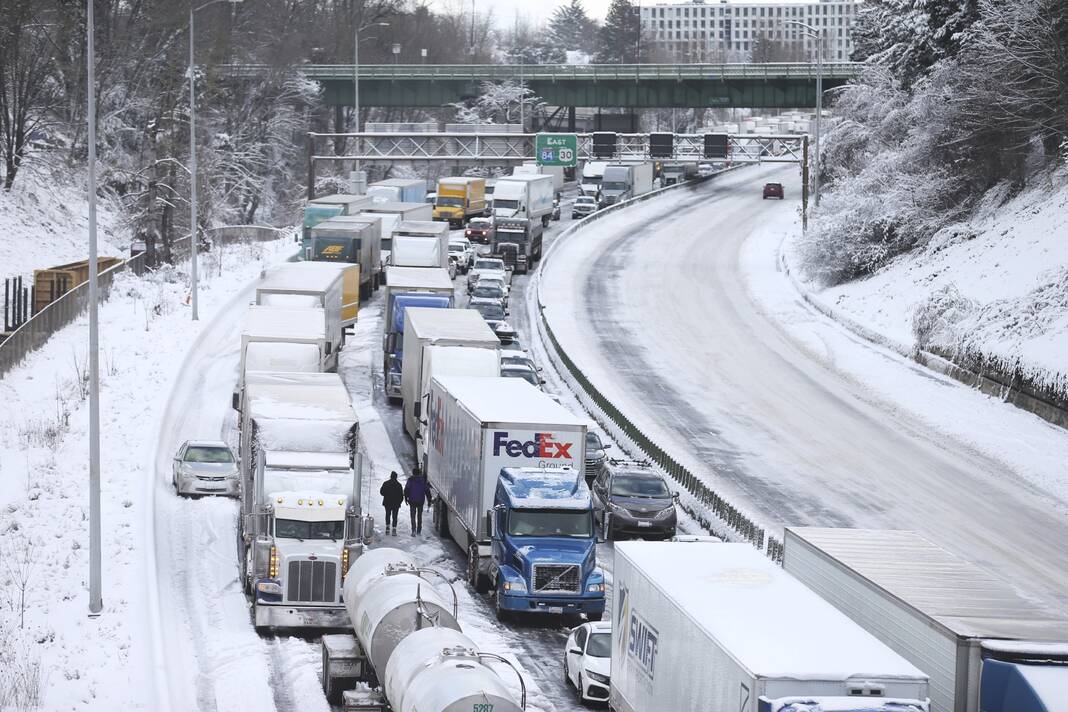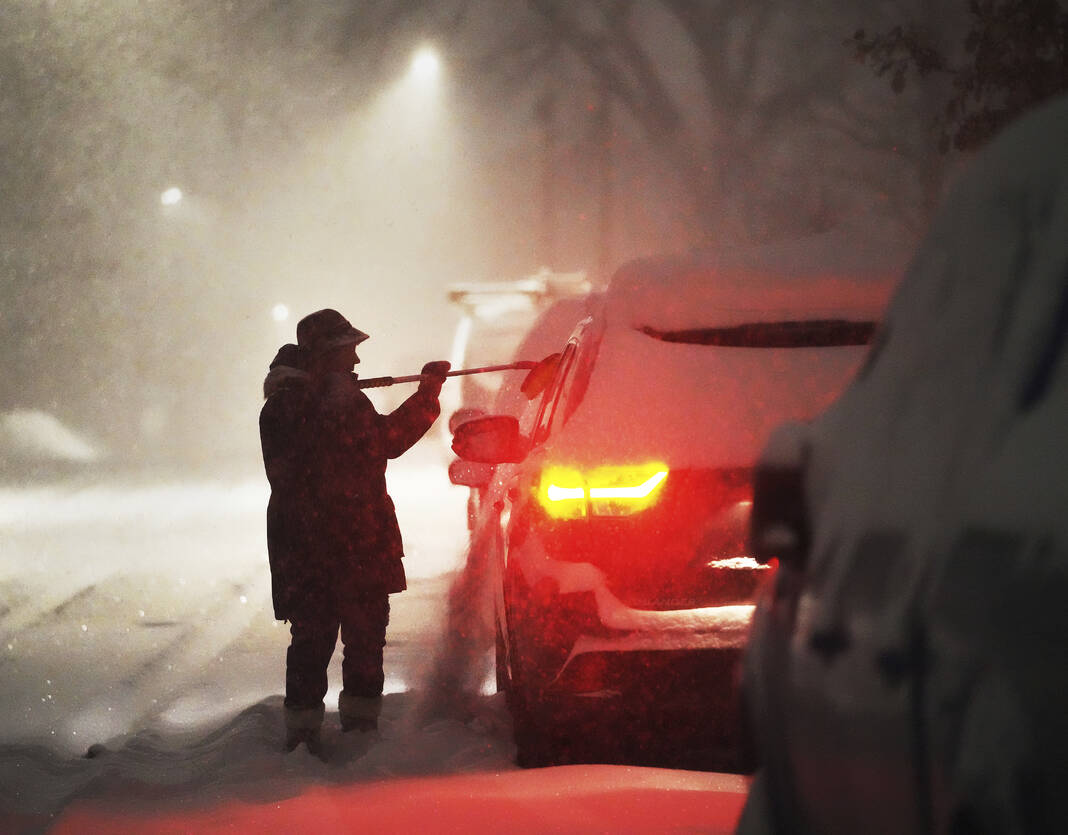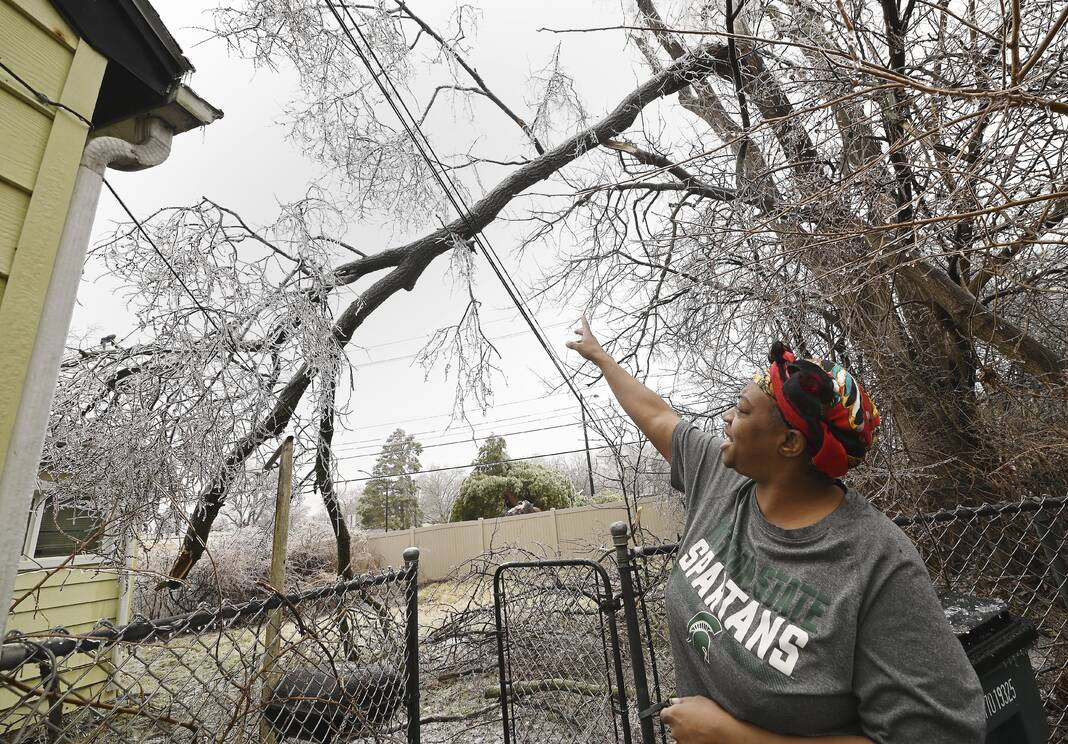
The backup of cars and trucks stuck on Interstate 84 is seen from the Blumenauer Bicycle and Pedestrian Bridge in Northeast Portland, Ore., Thursday, Feb. 23, 2023. Nearly a foot of snow fell in Portland on Wednesday. (Dave Killen /The Oregonian via AP)


PORTLAND, Ore. (AP) — Winter storms sowed more chaos across the U.S. on Thursday, shutting down much of Portland with almost a foot of snow and paralyzing travel from parts of the Pacific Coast all the way to the northern Plains.
The nearly 11 inches that fell in Portland amounted to the second snowiest day in the city’s history. It took drivers by surprise, stalling traffic during the Wednesday evening rush hour and trapping motorists on freeways for hours. Some spent the night in their vehicles or abandoned them altogether as crews struggled to clear roads. Other commuters got off spun-out buses and walked in groups to safety.
The storms also knocked out power to hundreds of thousands of homes in multiple states and grounded or delayed thousands of flights.
Marco Ortiz, 33, was one of many Portland drivers who got stuck on a busy highway that winds through the steep hills of southwest Portland. His normal 30-minute commute stretched into six hours as heavy snow brought traffic to a standstill. Ortiz finally decided to abandon his Prius and walk a mile through the storm to the nearest train station to get home.
He walked past other drivers abandoning their stuck cars as well and spotted a tree that had fallen onto the roadway.
“I just ended up giving up,” Ortiz said Thursday. “I almost got myself in a car accident because I tried to go through the snow, but my car was just sliding and sliding.”
Other people reveled in the surprise day off in a place that rarely gets measurable snow.
Joan Jasper snapped on skis and was gliding through a residential neighborhood.
“They always have like ‘snowmageddon’ on the news, and so we kind of ignored it — and 11 inches later here we are!” she said. “This is gorgeous.”
For the first time since 1989, the National Weather Service issued a blizzard warning for the Southern California mountains. Forecasters predicted “multiple rounds” of snow, with accumulations of 3 to 5 feet (0.91 to 1.5 meters) predicted for the Sierra Nevada region.
Snow was also expected over some lower foothills and valley areas near the Pacific Coast, the weather service said.
Large amounts of moisture in the air also created an increased risk of flash flooding, forecasters said. Some coastal areas could see waves as high as 10 to 14 feet (3 to 4 meters) through Thursday, forecasters said.
In Wyoming, roads across much of the southern part of the state were impassable, state officials said.
Rescuers tried to reach stranded motorists, but high winds and drifting snow created a “near-impossible situation,” said Sgt. Jeremy Beck of the Wyoming Highway Patrol.
High winds and heavy snow in the Cascade Mountains prevented search teams from reaching the bodies of three climbers killed over the weekend in an avalanche on Washington’s Colchuck Peak.
Portland residents had expected no more than a dusting to a few inches. The city uses salt on its roads only in extreme situations for environmental reasons, and the chaos Thursday recalled a similar storm in 2017 that left motorists stranded on freeways and shut down the city for days.
The weather service originally predicted a 20% chance that Portland would get more than 2 inches (5 centimeters) of snow. The probability of getting 6 to 8 inches (15 to 20 centimeters) was only around 5%.
The forecast changed rapidly within hours as the storm approached, said Colby Neuman, a weather service meteorologist in Portland.
He said forecasters would review the storm to try to figure out why so many models were wrong.
“There’s a balance there between crying wolf and also informing people so they can make their own decisions,” he said.
In Arizona, several interstates and other highways were closed due to high winds, falling temperatures and blowing snow. The state Department of Transportation advised people not to travel. Forecasters said snow could fall at a rate of 2 to 3 inches (5 to 8 centimeters) per hour.
A blizzard warning was in effect through Saturday in California for higher elevations of the Sierra Nevada, where forecasters predicted several feet of snow, 60 mph (96 kph) gusts and wind chills as low as minus 40 degrees (minus 40 Celsius).
In the state capital of Sacramento, the weather service said it had received reports of something that might be either hail or graupel — soft, wet snowflakes encased in supercooled water droplets.
Electrical grids took a beating in the north as heavy ice and gusty winds knocked down power lines. In California, lines were fouled with tree branches and other debris.
A Michigan firefighter died Wednesday after coming in contact with a downed power line in the village of Paw Paw, authorities said. Van Buren County Sheriff Dan Abbott called it a tragic accident that was “no fault of the firefighter.”
Michigan utilities reported more than 700,000 customers without electricity, mostly in the state’s southeast corner, where power lines and trees were shrouded in ice. DTE Energy said some outages could last through the weekend.
Afternoon temperatures in the 40s were expected to melt the ice, but DTE said it was bracing for more broken lines.
“A quarter-inch of ice on an electrical system is the equivalent of a baby grand piano hanging on those wires,” said Trevor Lauer, the president of DTE’s electric arm.
As of Thursday morning, more than 681,000 customers were without power in Michigan; over 84,000 in Illinois; over 58,000 in Wisconsin; about 42,000 in California and about 32,000 in New York state, according to the website PowerOutage.us.
Weather also contributed to another day of problems at the nation’s airports. Almost 2,000 flights were canceled by Thursday afternoon, according to the tracking service FlightAware. Another 12,500-plus flights were delayed across the country.
In a few places, the snow offered a delightful diversion. Karen Krenis was driving to a pottery studio Thursday in Santa Cruz, California, when she stopped in her tracks after seeing snow on the beach.
“I have lived in California for 30 years, and I’ve never seen anything like it. This is insane!” Krenis said.
She said she got out of her car and went to the beach to take photos. By the time she left, about 50 other people were already there. Adults were snapping photos and children were making snowballs in a “crazy, fun scene.”
___
Salter reported from O’Fallon, Missouri. Associated Press writer Andrew Selsky in Salem, Oregon, Olga Rodriguez in San Francisco and other AP reporters from around the country contributed to this report.

